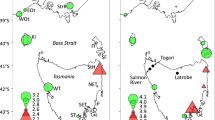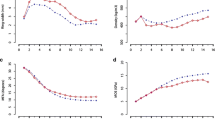Abstract
Eucalyptus nitens plantations are generally established for pulpwood production but an increasing area is being managed for solid wood. Genetic variation in, and correlations among, three Kraft pulpwood traits (diameter at breast height, basic density and near-infrared-predicted cellulose content) and three 12-mm wood-core shrinkage traits (recoverable collapse, net shrinkage and gross shrinkage) were examined, utilising data from two 9-year-old first-generation progeny trials in Tasmania. These trials contained approximately 400 open-pollinated families (over 100 of which were sampled for wood properties) representing three central-Victorian E. nitens races. Significant genetic variation at the race and/or within-race level was identified in all traits. Within races, relative levels of additive genetic variation were higher for shrinkage traits, although narrow-sense heritabilities were lower and the expression of genetic variation less stable across sites than for other wood property traits. Heterogeneous intertrait genetic correlations were identified across sites between growth and some wood property traits. However, where significant, genetic correlations indicated that within-race selection for growth would adversely affect core basic density and all core shrinkage traits. Furthermore, results based on cores suggested that within-race selection for higher basic density would favourably impact on cellulose content and collapse but selection for either higher basic density or cellulose content would adversely affect net shrinkage. Most within-race genetic variation in gross shrinkage appeared to be due to genetic variation in collapse. The implications of these results for sawn timber breeding will depend on the strength of genetic correlations between core traits and rotation-age objective traits and objective trait economic weights.
Similar content being viewed by others
References
Arnold RJ, Johnson IG, Owen JV (2004) Genetic variation in growth, stem straightness and wood properties in Eucalyptus dunnii trials in Northern New South Wales. For Genetics 11:1–12
Borralho NMG, Cotterill PP, Kanowski PJ (1993) Breeding objectives for pulp production of Eucalyptus globulus under different industrial cost structures. Can J For Res 23:648–656
Burdon RD (1977) Genetic correlation as a concept for studying genotype–environment interaction in forest tree breeding. Silvae Genet 26:168–175
Cannon T, Innes T (2007) Markets for the wood products from non-durable hardwood sawlog plantations. In: Brown AG, Beadle CL (eds) Plantation eucalypts for high-value timber. Joint Venture Agroforestry Program, Melbourne, pp 109–124
Chafe SC (1992) Collapse: an introduction. CSIRO, Division of Forest Products, Melbourne
Chauhan SS, Walker J (2004) Relationships between longitudinal growth strain and some wood properties in Eucalyptus nitens. Aust For 67:254–260
Clarke CRE, Shaw MJP, Wessels AM, Jones WR (1999) Effect of differences in climate on growth, wood, and pulp properties of nine eucalypt species at two sites. Tappi J 82:89–99
Cook IO, Ladiges PY (1991) Morphological variation within Eucalyptus nitens s. lat. and recognition of a new species, E. denticulata. Aust Syst Bot 4:375–390
Dickson RL, Raymond CA, Joe W, Wilkinson CA (2003) Segregation of Eucalyptus dunnii logs using acoustics. For Ecol Manag 179:243–251
Dutkowski GW, Potts BM, Williams DR, Kube PD, McArthur C (2001) Geographic genetic variation in central Victorian Eucalyptus nitens. In: IUFRO Symposium on Developing the Eucalypt for the Future, CD-Rom communication. Instituto Forestal (INFOR), Valdivia, Chile
Gilmour AR, Gogel BJ, Cullis BR, Welham SJ, Thompson R (2002) ASReml user guide release 1.0. VSN International Ltd., Hemel Hempstead
Greaves BL, Borralho NMG (1996) The influence of basic density and pulp yield on the cost of eucalypt kraft pulping: a theoretical model for tree breeding. Appita J 49:90–93
Greaves BL, Borralho NMG, Raymond CA (1997) Breeding objective for plantation eucalypts grown for production of kraft pulp. For Sci 43:465–472
Greaves BL, Dutkowski G, McRae T (2004) Breeding objectives for Eucalyptus globulus for products other than kraft pulp. In: Borralho N, Pereira JS, Marques C, Coutinho J, Madeira M, Tomé M (eds) Eucalyptus in a changing world. Proceedings of an IUFRO conference. RAIZ, Aveiro, Portugal, pp 175–180
Griffin AR, Cotterill PP (1988) Genetic variation in growth of outcrossed, selfed and open-pollinated progenies of Eucalyptus regnans and some implications for breeding strategy. Silvae Genet 37:124–131
Hamilton MG, Potts BM (2008) Review of Eucalyptus nitens genetic parameters. N Z J For Sci 38:102–119
Hamilton M, Joyce K, Williams D, Dutkowski G, Potts B (2008a) Achievements in forest tree improvement in Australian and New Zealand. 9. Genetic improvement of Eucalyptus nitens in Australia. Aust For 71:82–93
Hamilton M, Raymond C, Potts B (2008b) The genetic correlation between air-dried density and basic density in Eucalyptus nitens wood cores. Silvae Genet (in press)
Hamilton MG, Potts BM, Harwood C, Apiolaza L, Gore P (2004) Comparison of non-destructive assessment techniques for shrinkage and collapse in Eucalyptus nitens. In: Borralho N, Pereira JS, Marques C, Coutinho J, Madeira M, Tomé M (eds) Eucalyptus in a changing world. Proceedings of an IUFRO conference. RAIZ, Aveiro, Portugal, pp 686–687
Haslett AN (1988) Properties and utilisation of exotic speciality timbers grown in New Zealand. Part V: Ash eucalypts and Eucalyptus nitens. Forest Research Institute, Rotorua
Houle D (1992) Comparing evolvability and variability of quantitative traits. Genetics 130:195–204
INFOR (2004) Eucalyptus nitens en Chile: Primera Monografía. Instituto Forestal (INFOR), Valdivia
Kingston RST, Risdon CJE (1961) Shrinkage and density of Australian and other South-west Pacific woods. CSIRO, Melbourne
Kube PD, Raymond CA (2002) Prediction of whole-tree basic density and pulp yield using wood core samples in Eucalyptus nitens. Appita J 55:43–48
Kube PD, Raymond CA (2005) Breeding to minimise the effects of collapse in Eucalyptus nitens. For Genetics 12:23–34
Lausberg MJF, Gilchrist KF, Skipwith JH (1995) Wood properties of Eucalyptus nitens grown in New Zealand. N Z J For Sci 25:147–163
Matheson AC, Raymond CA (1984) Effects of thinning in progeny tests on estimates of genetic parameters in Pinus radiata. Silvae Genet 33:125–128
McKenzie HM, Shelbourne CJA, Kimberley MO, McKinley RB, Britton RAJ (2003a) Processing young plantation-grown Eucalyptus nitens for solid-wood products. 2: Predicting product quality from tree, increment core, disc, and 1-m billet properties. N Z J For Sci 33:79–113
McKenzie HM, Turner JCP, Shelbourne CJA (2003b) Processing young plantation-grown Eucalyptus nitens for solid-wood products. 1: Individual-tree variation in quality and recovery of appearance-grade lumber and veneer. N Z J For Sci 33:62–78
McKimm RJ, Waugh G, Northway RL (1988) Utilisation potential of plantation-grown Eucalyptus nitens. Aust For 51:63–71
Medhurst JL, Beadle CL, Neilsen WA (2001) Early-age and later-age thinning affects growth, dominance, and intraspecific competition in Eucalyptus nitens plantations. Can J For Res 31:187–197
Nolan G, Innes T, Redman A, McGavin R (2003) Australian hardwood drying best practice manual. Forest and Wood Products Research and Development Corporation, Melbourne
Nolan G, Washusen R, Jennings S, Greaves B, Parsons M (2005) Eucalypt plantations for solid wood products in Australia—a review. Forest and Wood Products Research and Development Corporation, Melbourne
Parsons M, Gavran M, Davidson J (2006) Australia's plantations 2006. Bureau of Rural Sciences, Commonwealth of Australia, Canberra
Pederick LA (1979) Natural variation in shining gum (Eucalyptus nitens). Aust For Res 9:41–63
Poke FS, Wright JK, Raymond CA (2004) Predicting extractives and lignin contents in Eucalyptus globulus using near infrared reflectance analysis. J Wood Chem Technol 24:55–67
Raymond CA (2000) Tree breeding issues for solid wood production. The future of eucalypts for wood products. In: Proceedings of an IUFRO Conference. Forest Industries Association of Tasmania, Launceston, Tasmania, pp 310–316
Raymond CA, Muneri A (2001) Nondestructive sampling of Eucalyptus globulus and E. nitens for wood properties. I. Basic density. Wood Sci Tech 35:27–39
Raymond CA, Schimleck LR (2002) Development of near infrared reflectance analysis calibrations for estimating genetic parameters for cellulose content in Eucalyptus globulus. Can J For Res 32:170–176
Raymond CA, Savage L, Harwood C (2004) Longitudinal patterns of volumetric shrinkage and collapse in Eucalyptus globulus and E. nitens. In: Borralho N, Pereira JS, Marques C, Coutinho J, Madeira M, Tomé M (eds) Eucalyptus in a changing world. Proceedings of an IUFRO conference. RAIZ, Aveiro, Portugal, p 701
Reid R, Washusen R (2001) Sawn timber from 10-year-old pruned Eucalyptus nitens (Deane & Maiden) grown in an agricultural riparian buffer. In: Rutherford I, Sheldon F, Brierley G, Kenyon C (eds) Third Australian Stream Management Conference proceedings: the value of healthy streams. Cooperative Research Centre for Catchment Hydrology, Brisbane, pp 545–550
Schimleck LR, Wright PJ, Michell AJ, Wallis AFA (1997) Near-infrared spectra and chemical compositions of E. globulus and E. nitens plantation woods. Appita J 50:40–46
Schimleck LR, Kube PD, Raymond CA (2004) Genetic improvement of kraft pulp yield in Eucalyptus nitens using cellulose content determined by near infrared spectroscopy. Can J For Res 34:2363–2370
Shelbourne CJA, Nicholas ID, McKinley RB, Low CB, McConnochie RM, Lausberg MJF (2002) Wood density and internal checking of young Eucalyptus nitens in New Zealand as affected by site and height up the tree. N Z J For Sci 32:357–385
Svensson S, Martensson A (1999) Simulation of drying stresses in wood. Part I: Comparison between one- and two-dimensional models. Holz als Roh- und Werkstoff 57:129–136
Swain TL, Gardner RAW (2003) A summary of current knowledge of cold tolerant eucalypt species (CTE's) grown in South Africa. Institute for Commercial Forestry Research (ICFR), Scottsville
TAPPI (1989) Basic density and moisture content of pulpwood. Technical Association of the Pulp and Paper Industries (TAPPI), South Norcross
Tibbits WN, Hodge GR (1998) Genetic parameters and breeding value predictions for Eucalyptus nitens wood fiber production traits. For Sci 44:587–598
Valencia J (2008) Application of non-destructive evaluation methods to the prediction of solid-wood suitability of Eucalyptus nitens plantation-grown timber. Masters thesis, School of Plant Science, University of Tasmania, Hobart, Tasmania
Walker JCF, Butterfield BG, Langrish TAG, Harris JM, Uprichard JM (1993) Primary wood processing: principles and practice, 1st edn. Chapman and Hall, London
Wallis AFA, Wearne RH, Wright PJ (1996a) Analytical characteristics of plantation eucalypt woods relating to kraft pulp yields. Appita J 49:427–432
Wallis AFA, Wearne RH, Wright PJ (1996b) Chemical analysis of polysaccharides in plantation eucalypt woods and pulps. Appita J 49:258–262
Wallis AFA, Wearne RH, Wright PJ (1997) New approaches to the rapid analysis of cellulose in wood. In: Proceedings of the 9th International symposium on wood and pulping chemistry. Canadian Pulp and Paper Association, Montreal, Quebec, pp C3-1–C3-4
Washusen R (2001) Native forest processing strategies look good for plantation E. nitens. Onwood 35:4
Washusen R, Ilic J (2001) Relationship between transverse shrinkage and tension wood from three provenances of Eucalyptus globulus Labill. Holz als Roh- und Werkstoff 59:85–93
Washusen R, Ades P, Evans R, Ilic J, Vinden P (2001) Relationships between density, shrinkage, extractives content and microfibril angle in tension wood from three provenances of 10-year-old Eucalyptus globulus Labill. Holzforschung 55:176–182
Waugh G, Yang J (1994) Opportunities for sawn products from Tasmanian plantation eucalypts. Faces of Farm Forestry. In: Proceedings of an Australian Forest Growers Conference, Launceston, Tasmania, pp 215–220
Acknowledgements
We thank René Vaillancourt, Luis Apiolaza, Greg Dutkowski and Peter Kube for sharing their professional expertise, Peter Volker for his role in obtaining the seed, growing seedlings, trial design and establishing the trials, Linda Ballard, Leon Savage and Judith Wright for their technical support, Forestry Tasmania and Norske Skog Paper Mills (Australia) Pty. Ltd. for access to their trials and trial data and the CRC for Sustainable Production Forestry (1997–2005) and Australian Research Council Linkage Grant (LP0453704) for funding.
Author information
Authors and Affiliations
Corresponding author
Additional information
Communicated by D. Grattapaglia
Rights and permissions
About this article
Cite this article
Hamilton, M.G., Raymond, C.A., Harwood, C.E. et al. Genetic variation in Eucalyptus nitens pulpwood and wood shrinkage traits. Tree Genetics & Genomes 5, 307–316 (2009). https://doi.org/10.1007/s11295-008-0179-4
Received:
Accepted:
Published:
Issue Date:
DOI: https://doi.org/10.1007/s11295-008-0179-4




